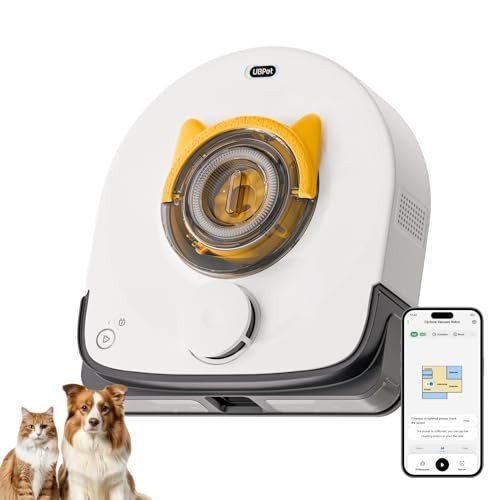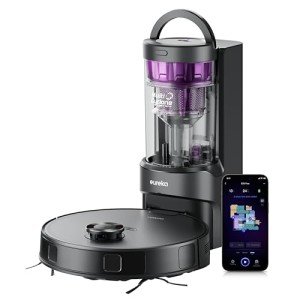What Experts In The Field Of Automatic Vacuum Cleaner Want You To Know…

2025-03-06 09:38
45
0
본문
 How to Choose an Automatic Vacuum Cleaner
How to Choose an Automatic Vacuum CleanerMany robotic vacuum cleaners come with sophisticated sensors and smart-mapping technology. These features assist them in navigating homes and [Redirect Only] get around difficult corners. These are also great for those suffering from allergies, since they help reduce the amount of dust and pet hair that comes in contact with them.
 The Eufy X10 is a top choice. It is equipped with the best affordable robot vacuum object avoidance technology in its class, which is specially trained to stay clear of socks, coffee bags, and other items. It is able to clean underneath the ottomans that are low.
The Eufy X10 is a top choice. It is equipped with the best affordable robot vacuum object avoidance technology in its class, which is specially trained to stay clear of socks, coffee bags, and other items. It is able to clean underneath the ottomans that are low.Self-charging
A self-charging robot vacuum cleaner is a great option for large homes or houses with multiple floors. Its large dust bin and long-lasting battery let it clean larger areas without having to return to the base. It also features the ability to eject it with one touch for easily emptying its contents into a trash can. Many robotic vacuums come equipped with HEPA filters that effectively trap fine dust and allergens for better living conditions.
A robot vac is a tiny machine equipped with a powerful motor that utilizes advanced sensors to study its surroundings. It then mixes roller brushes, side brushes, and mops to scrub floors thoroughly. After cleaning, it returns to the docking station to recharge and prepare for the next session. Unlike manual vacuums that can become clogged or distracted by pet hair or food particles, robovacs aren't. They are also quieter than traditional vacuums, making them an ideal option for homes with small apartments.
A few of the most popular robot vacuums available feature advanced navigation tools to assist them in navigating your home. They use lasers, sensors and cameras to create maps of your home and detect obstacles in its path. These navigation technologies allow the robot to change direction or take an efficient route. They can also detect steep drops and prevent the robot from tumbling down a flight of stairs. Many of these devices can be controlled with an app on your smartphone to set schedules and adjust your cleaning settings.
Automatic vacuums can also be programmed to run when you are away. This makes them ideal for those with busy schedules or who cannot afford to hire a housecleaner. Many robot vacuum owners have found that they save time and energy and have an improved home due to the use of their machines.
Some robot vacuums have a hard time dealing with large debris and may not be able to pick up pet hair or other small particles embedded in carpet fibers. They may also have trouble with dark floors. They may be stuck or stop under thresholds or furniture that is low. To avoid these problems, you can make use of the app to create virtual barriers and no-go zones. You can also program your robot to operate at specific times of the day, and create it to connect with other smart home systems.
Wi-Fi connectivity
Many smart vacuum cleaners perform well without Wi-Fi however, connecting your device to the internet opens up many advanced features that increase convenience and performance. They include precise home mapping, customizable cleaning preferences, and remote control using an app for mobile devices. Some even allow you to give your robot cleaner amazon a humorous name. The app can also send regular updates to the vacuum cleaner's firmware.
It is easy to connect an automated vacuum cleaner to WiFi, but you should follow the instructions from the manufacturer and verify your router's settings. The majority of newer vacuum cleaners utilize 2.4GHz wireless signals, which offer greater coverage and are more stable than 5GHz connections. However, some dual-band routers can transmit both 2.4GHz and 5GHz signals. If you're using a dual-band router, make sure to select the 2.4GHz network on your smartphone during setup.
The application for your robot is typically easy to use and allows you to begin, stop and schedule cleaning sessions. Some models can also be integrated with Amazon Alexa or Google Assistant. This lets you engage the robot by using voice commands. This feature is particularly beneficial for busy families and pet owners, as it lets you free your hands so that you can focus on other things.
You can also customize the app by setting up no-go zones or altering cleaning modes. Some apps can even create heat maps to help understand your home's dirtiest areas and adjust your robot's suction level accordingly. You can also alter the cleaning preferences or schedules for each room. Certain models allow you to pause and restart cleaning sessions.
It is vital that your robot vacuum has a solid connection to the internet. Check to make sure it's not experiencing connectivity problems and that it has an effective Wi-Fi signal. If your vacuum is having difficulty connecting to the Internet try moving it closer to your router or using an extender for Wi-Fi to increase the strength of your signal. If the problem continues it could be the right time to contact your router's customer support team.
Navigation system
A robotic vacuum's navigation system plays a vital role in its ability to stay clear of obstacles and thoroughly clean. There are many different types of navigation systems, ranging from simple bump sensors to the most advanced mapping technology. The right choice will make your robot vacuum cleaner more efficient and efficient.
The navigation of most basic robot vacuums is based on a combination between sensors and algorithms. They utilize bump sensors to detect solids, and an infrared sensors to detect cold or hot objects. This allows the robot to avoid furniture and other large, heavy objects. The sensors also aid the robot to track its location in space, which is essential to ensure that it is navigating accurately.
More advanced robot vacuum cleaner on sale vacuums use cameras to improve the accuracy of navigation. Cameras use an optical sensor and lens to capture images of the surroundings that it analyzes to determine its location. The robot also uses the information from the images to find obstructions and map to map out its route. Additionally the camera is able to recognize objects like windows and doors and avoid them.
The most advanced robotic vacuums use LIDAR to scan the room and generate 3D maps. This technology is similar to the system used by self-driving cars. In contrast to other types of sensors, LIDAR is less affected by changes in lighting conditions. This is why it is ideal in rooms with a wide variety of lighting conditions.
ECOVACS DEEBOTs use this cutting-edge technology in their newest models. The mapping capabilities of their newest models, paired with dToF navigation, produce more precise maps of the home than traditional sensors. The robot can detect obstacles in real-time and plan the best cleaning route automatically. It also removes the requirement for manual intervention and ensures comprehensive cleaning.
While a vacuum cleaner with a basic navigation system will eventually sweep your home, it will take a long time and may miss some areas. A more sophisticated navigation system will not make as many mistakes and be more efficient. A robotic vacuum that is equipped with an application for mapping will not only be able to recognize obstacles but also remember its movements as well as the details of cleaning. This will enable the robotic vacuum to return to an area without needing to retrace their journey.
Battery life
The battery life of robot vacuum cleaners is essential to its efficiency. The battery life of the robot vacuum cleaner is contingent on the frequency at which it is used, the long it is running and charging and the type of debris it gathers. A high-quality robot Vacuum near Me will automatically return to its dock and charge when needed. You can prolong the life of a robot's battery by cleaning it regularly and getting rid of hair from the suction system. Cleaning the device will also decrease its energy consumption.
The majority of robots use lithium-ion batteries that provide high power density and long cycle life. The older models had nickel-metal-hydride battery which had a shorter life and required longer recharge times. If your robot is running the nickel-metal hydride battery change to a lithium-ion model to improve performance.
To ensure that your robot's battery is optimized for performance, you should consider placing it in a dry, 1borsa.com cool place and getting rid of potential hazards from liquids, such as spills or open water bottles. Liquids may damage electronic components and reduce battery performance, which could lead to premature failure.
A well-maintained robot can last for four years or more, depending on the model and brand. Regular maintenance includes removing debris from the wheels, checking for sharp objects and blocks and washing mop heads on a regular basis. Moreover you should clean the dust bin of your vacuum and empty it after each use. Examine the battery for signs that it's worn out.
When you are buying a robot, you should take into consideration the cleaning performance as well as the navigational and mapping capabilities as well as obstacles-avoiding features. These features ensure that the robot is moving in the correct direction and avoids collisions with furniture pets, as well as other obstacles. A quality robot will also be able to adjust its cleaning mode according to the flooring type, whether it's a carpet with stains or bare hardwood flooring.
If your robotic vacuum cleaner has a self-emptying bin, you should empty it when it is full to prevent overflowing. It is also important to look for any clogs or other debris, as these can cause your vacuum to lose suction. You can map the room and set up no-go areas via the app if have an intelligent model. The advanced sensors of the model allow it to walk up doors and prevent it from falling off stairs or ledges.

댓글목록0